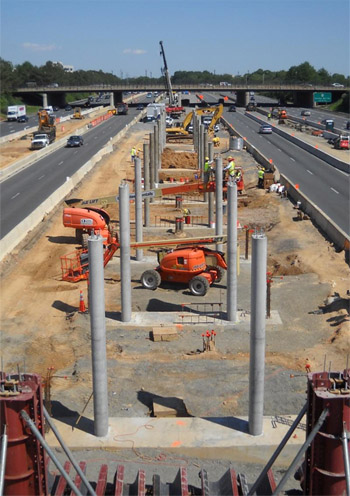Today's Washington Post reported that the estimated costs for Phase 2 of the Silver Line are much higher than originally estimated. The part of those estimates associated with the Dulles station, $640 million higher to place it immediately adjacent to the terminal, must be highly inflated.
The original costs of Phase 2 were in the $2.5 - $3 billion range. The new estimates add about $600 million. Keep in mind that these are preliminary engineering studies and are thus subject to significant revision.
Specifically, though, this article reports that the costs associated with the Dulles stop would be $640 million lower by putting the stop 600 feet away rather than immediately in front of the terminal as originally planned.
This is a recent issue, and here are two recent GGW posts that deal with this:
The $640 million cost associated with this is totally absurd. That is more than the Woodrow Wilson Bridge cost, which is two superstructures across a major river over a mile long. Give me a break. It will not cost $1,000,000 per foot. The reason this cost estimate is so high is because the people doing the estimates are being constrained and not allowed to think outside the box. I am way out of my league here, since I am no engineeer. But I suspect that the costs are being driven by the assumption that the rail line and station need to be shoehorned in without making any changes to the existing access to Dulles by cars.
However, if one were to instead look at the situation as a clean slate and redesign access for all modes as part of the project, it would have to cost way less than that. I imagine one could demolish the entire infrastructure in front of the terminal and completely rebuild it for less than $640 million. What is needed is vision. Ask the simpler question, "How could easy and optimal access for the rail line and cars be accomplished most effectively given the existing space?" If it's cheaper to tear out some of the roads and then put them back somewhere else than to try to dig a tunnel for the train, then do that instead. There has to be creative solutions that will put the terminal where it belongs--inside--for a lot, lot less than $640 million.
Regardless, I stand by my comment I posted to GGW back on August 13:
"I cannot imagine an airport siting its automobile passenger drop-off 600 feet from the terminal entrance. It's the accumulation of these little "compromises" that eventually add up to a system that is inconvenient, as Reza rants about above. Where do we stop? If 600 feet is no big deal, then what about 700? or 800? The mindset is just wrong.
"It's no different than making 10-minute headways into 14-minute headways on a train line (average waiting time goes up 2 minutes). Hey, it saves some money and is only a *minor* inconvenience, why not? Well, if it's already 14 minutes, then make it a round 15 for simplicity's sake. And you know the rest.
"Design and architecture send signals. The signal being sent by this design will be--for the decades it is in existence--that Metro is the second-class mode people ought to use to travel to the airport. On the other hand, imagine that the station for the Silver Line were actually MORE convenient than being dropped at the curb. Imagine that! A station located and designed so that every airport user says, 'Wow! Look how convenient and cool that is.' As it is with this new proposal, it will be essentially completely out of sight, and many people probably won't even know it exists. Then what signal is being sent? That, in my opinion, is the much bigger value."
skip to main |
skip to sidebar

Sustainability Professional. Chair, Green Business Roundtable
Transform markets. Transform society. Transform behavior. Transform industry. Transform institutions. Transform economics. Transform architecture. Transform land use. Transform agriculture. Transform cities. Transform transportation. Transform education. Transform government. Transform thinking. Transform doing. Transform everything. Transform to Sustainability.
Steve Offutt

Sustainability Professional. Chair, Green Business Roundtable
Search This Blog
Steve Offutt's postings elsewhere
Blog Archive
-
▼
2010
(145)
-
▼
September
(9)
- Can Capital Bikeshare get up and running in time f...
- Monday What's on the Web: Street Films
- Capital Bikeshare launch - Some photos
- Monday What's on the Web: The Story of Stuff
- Reports on Costs of Dulles Stop on Silver Line are...
- Meet the Arlington Bicycle Advisory Committee (and...
- Monday What's on the Web: The Washcycle
- Deutsche Bank Crushes Skeptic Arguments
- Monday What's on the Web: Next American City
-
▼
September
(9)




No comments:
Post a Comment